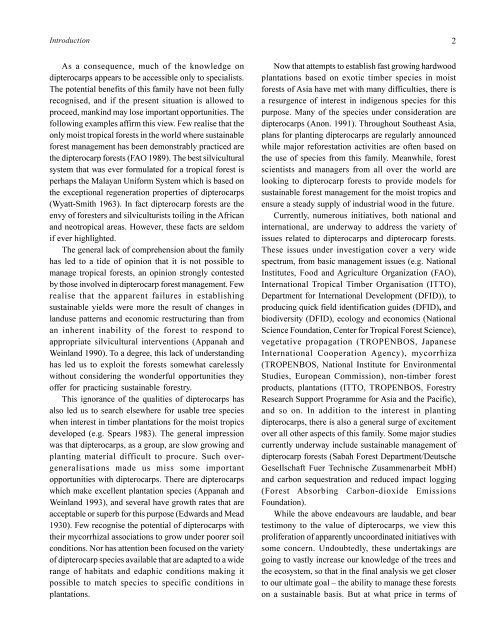A review of dipterocarps - Center for International Forestry Research
A review of dipterocarps - Center for International Forestry Research
A review of dipterocarps - Center for International Forestry Research
You also want an ePaper? Increase the reach of your titles
YUMPU automatically turns print PDFs into web optimized ePapers that Google loves.
Introduction<br />
As a consequence, much <strong>of</strong> the knowledge on<br />
<strong>dipterocarps</strong> appears to be accessible only to specialists.<br />
The potential benefits <strong>of</strong> this family have not been fully<br />
recognised, and if the present situation is allowed to<br />
proceed, mankind may lose important opportunities. The<br />
following examples affirm this view. Few realise that the<br />
only moist tropical <strong>for</strong>ests in the world where sustainable<br />
<strong>for</strong>est management has been demonstrably practiced are<br />
the dipterocarp <strong>for</strong>ests (FAO 1989). The best silvicultural<br />
system that was ever <strong>for</strong>mulated <strong>for</strong> a tropical <strong>for</strong>est is<br />
perhaps the Malayan Uni<strong>for</strong>m System which is based on<br />
the exceptional regeneration properties <strong>of</strong> <strong>dipterocarps</strong><br />
(Wyatt-Smith 1963). In fact dipterocarp <strong>for</strong>ests are the<br />
envy <strong>of</strong> <strong>for</strong>esters and silviculturists toiling in the African<br />
and neotropical areas. However, these facts are seldom<br />
if ever highlighted.<br />
The general lack <strong>of</strong> comprehension about the family<br />
has led to a tide <strong>of</strong> opinion that it is not possible to<br />
manage tropical <strong>for</strong>ests, an opinion strongly contested<br />
by those involved in dipterocarp <strong>for</strong>est management. Few<br />
realise that the apparent failures in establishing<br />
sustainable yields were more the result <strong>of</strong> changes in<br />
landuse patterns and economic restructuring than from<br />
an inherent inability <strong>of</strong> the <strong>for</strong>est to respond to<br />
appropriate silvicultural interventions (Appanah and<br />
Weinland 1990). To a degree, this lack <strong>of</strong> understanding<br />
has led us to exploit the <strong>for</strong>ests somewhat carelessly<br />
without considering the wonderful opportunities they<br />
<strong>of</strong>fer <strong>for</strong> practicing sustainable <strong>for</strong>estry.<br />
This ignorance <strong>of</strong> the qualities <strong>of</strong> <strong>dipterocarps</strong> has<br />
also led us to search elsewhere <strong>for</strong> usable tree species<br />
when interest in timber plantations <strong>for</strong> the moist tropics<br />
developed (e.g. Spears 1983). The general impression<br />
was that <strong>dipterocarps</strong>, as a group, are slow growing and<br />
planting material difficult to procure. Such overgeneralisations<br />
made us miss some important<br />
opportunities with <strong>dipterocarps</strong>. There are <strong>dipterocarps</strong><br />
which make excellent plantation species (Appanah and<br />
Weinland 1993), and several have growth rates that are<br />
acceptable or superb <strong>for</strong> this purpose (Edwards and Mead<br />
1930). Few recognise the potential <strong>of</strong> <strong>dipterocarps</strong> with<br />
their mycorrhizal associations to grow under poorer soil<br />
conditions. Nor has attention been focused on the variety<br />
<strong>of</strong> dipterocarp species available that are adapted to a wide<br />
range <strong>of</strong> habitats and edaphic conditions making it<br />
possible to match species to specific conditions in<br />
plantations.<br />
Now that attempts to establish fast growing hardwood<br />
plantations based on exotic timber species in moist<br />
<strong>for</strong>ests <strong>of</strong> Asia have met with many difficulties, there is<br />
a resurgence <strong>of</strong> interest in indigenous species <strong>for</strong> this<br />
purpose. Many <strong>of</strong> the species under consideration are<br />
<strong>dipterocarps</strong> (Anon. 1991). Throughout Southeast Asia,<br />
plans <strong>for</strong> planting <strong>dipterocarps</strong> are regularly announced<br />
while major re<strong>for</strong>estation activities are <strong>of</strong>ten based on<br />
the use <strong>of</strong> species from this family. Meanwhile, <strong>for</strong>est<br />
scientists and managers from all over the world are<br />
looking to dipterocarp <strong>for</strong>ests to provide models <strong>for</strong><br />
sustainable <strong>for</strong>est management <strong>for</strong> the moist tropics and<br />
ensure a steady supply <strong>of</strong> industrial wood in the future.<br />
Currently, numerous initiatives, both national and<br />
international, are underway to address the variety <strong>of</strong><br />
issues related to <strong>dipterocarps</strong> and dipterocarp <strong>for</strong>ests.<br />
These issues under investigation cover a very wide<br />
spectrum, from basic management issues (e.g. National<br />
Institutes, Food and Agriculture Organization (FAO),<br />
<strong>International</strong> Tropical Timber Organisation (ITTO),<br />
Department <strong>for</strong> <strong>International</strong> Development (DFID)), to<br />
producing quick field identification guides (DFID), and<br />
biodiversity (DFID), ecology and economics (National<br />
Science Foundation, <strong>Center</strong> <strong>for</strong> Tropical Forest Science),<br />
vegetative propagation (TROPENBOS, Japanese<br />
<strong>International</strong> Cooperation Agency), mycorrhiza<br />
(TROPENBOS, National Institute <strong>for</strong> Environmental<br />
Studies, European Commission), non-timber <strong>for</strong>est<br />
products, plantations (ITTO, TROPENBOS, <strong>Forestry</strong><br />
<strong>Research</strong> Support Programme <strong>for</strong> Asia and the Pacific),<br />
and so on. In addition to the interest in planting<br />
<strong>dipterocarps</strong>, there is also a general surge <strong>of</strong> excitement<br />
over all other aspects <strong>of</strong> this family. Some major studies<br />
currently underway include sustainable management <strong>of</strong><br />
dipterocarp <strong>for</strong>ests (Sabah Forest Department/Deutsche<br />
Gesellschaft Fuer Technische Zusammenarbeit MbH)<br />
and carbon sequestration and reduced impact logging<br />
(Forest Absorbing Carbon-dioxide Emissions<br />
Foundation).<br />
While the above endeavours are laudable, and bear<br />
testimony to the value <strong>of</strong> <strong>dipterocarps</strong>, we view this<br />
proliferation <strong>of</strong> apparently uncoordinated initiatives with<br />
some concern. Undoubtedly, these undertakings are<br />
going to vastly increase our knowledge <strong>of</strong> the trees and<br />
the ecosystem, so that in the final analysis we get closer<br />
to our ultimate goal – the ability to manage these <strong>for</strong>ests<br />
on a sustainable basis. But at what price in terms <strong>of</strong><br />
2

















